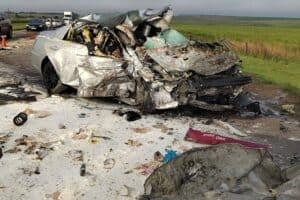'If we fail to protect them, future generations will only read about the horses instead of seeing them.'

It is still unclear who is supposed to protect the endangered iconic wild horses of Kaapsehoop near Mbombela, Mpumalanga.
The horses are found within different pine and gum tree plantations in the area. Residents of Kaapsehoop, who are volunteering to ensure that the horses are preserved, have called on the government, business people and animal lovers to assist in saving the diminishing population.
Adele Willenbrock, one of the community members taking care of the horses, said there was a need to preserve the horses for future generations. Willenbrock said the horses were endangered by illegal mining activities, disease, vehicles and poaching in the area.

Pictures: Adele Willenbrock
“Sometimes I use my own money to buy the resources used in taking care of the horses. I always travel around to check if they are safe.
“When I find that some of them are sick or injured, I interact with fellow volunteers and contact the veterinary surgeon to assist.
“As a community, we are trying our best to preserve this precious heritage, but it’s hard. We need support from the authorities or businesspeople.
ALSO READ: Ekhurhuleni responds to claims EMPD horses are starving, thin and weak
“If we fail to protect them, future generations will only read about the horses instead of seeing them. We had more than 170 horses, but now we only have 47.
“A few years ago, we lost 10 horses after a fire gutted the area. Recently, we lost six due to tick diseases, while some were killed by speeding vehicles.
“Last year, we rescued six horses who were found stuck in poachers’ traps.”
‘Horses are part of heritage’
Some researchers have said the horses were left in the area during the Anglo-Boer War, while others believed they were used by people hunting for gold.
Andrea Fourie, spokesperson for the Wild Horse Fund, said they had tried in vain to convince the Mpumalanga government to reduce the speed limit from 100 to 60km/h in the area where the houses are found.
ALSO READ: Horses were way ahead of the internet: A history lesson
“About three years ago, we wrote a letter to the department of community safety, and they promised to attend to our concern, but nothing was done.
“This year in March, we lost another two horses after they were knocked down by vehicles. These horses are part of the heritage and local and international tourists visit our area just to see the horses.
“We are a small community of about 240 households and 80% of the population are doing tourism orientated business,” said Fourie.

Pictures: Adele Willenbrock
She also appealed to the government to assist them in managing cattle herds that mix with the wild horses, as they infect the latter with diseases.
Recently, the Mpumalanga legislature adopted a DA motion for the provincial government to implement strategies to prevent the animal population from diminishing.
ALSO READ: Get ready for a reset: Just you, a horse and Mother Nature
Tersia Marshall, DA member in the legislature, said: “These mystical animals are not only of immense cultural and environmental value, but also constitute a vital attraction contributing meaningfully to the local tourism economy.”
Dialogue with local authorities
Jason Blockley, from the Society for the Prevention of Cruelty to Animals (SPCA), said it can only be involved to a limited extent in saving the horses.
“These horses are indeed a unique and much-loved feature of the region, admired for their mystique, beauty and historic presence.
“As the SPCA, our mandate focuses on preventing cruelty and responding to animal suffering. Since these horses are considered wild and free-roaming, our involvement is limited unless an animal is injured, suffering or in immediate distress.
“In such cases, we always assist to the best of our ability. Unfortunately, the challenges around protecting these horses are complex.
ALSO READ: Meet the top-ranked racehorse in the world
“To prevent road fatalities, the area would need to be enclosed with fencing extensive enough to allow the animals to roam freely while also keeping them safe.
“This kind of infrastructure would be a significant undertaking and would require coordination among various stakeholders, including local authorities and conservation experts.”
Blockley said the SPCA would welcome dialogue with local authorities, conservationists and community members to explore long-term solutions that balance animal welfare with ecological and tourism considerations.
Mbombela municipality spokesperson Joseph Ngala said: “We cannot always agree on a management model”.
“As much as they are part of the heritage, the horses are found on private properties, giving us very little chance to plan from a nature conservation point of view.
“As the city, we can ensure the areas where they roam are not developed so their habitat is not destroyed.”






